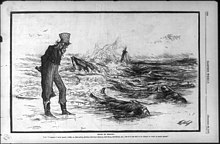US Life-Saving Service

The US Life-Saving Service was an independent state sea rescue organization under the jurisdiction of the US Treasury Department and existed from 1878 to 1915.
history
After the American Civil War, the underfunded state rescue service was in disrepair, and when a devastating storm killed many off the east coast in 1870, newspaper publishers began calling for a rescue reform. From 1871 Sumner Increase Kimball obtained budget increases and an expansion of the coastal rescue stations from the Treasury. In 1878 the state coastal rescue system, which had meanwhile also been expanded to the west coast and Alaska, was transferred to an independent agency, the US Life-Saving Service. This was subordinate to the Ministry of Finance and was directed by the super-indendent Kimball. Lifeboat stations have been set up near ports and exposed coastal areas and on the great lakes. In addition, shelters were maintained for possible survivors of shipwrecks along the coast of South Carolina , Georgia and Florida . On January 28, 1915, the service was combined with the US Revenue Cutter Service to form the US Coast Guard .
literature
- James W. Claflin: Lighthouses and Life Saving Along Cape Cod . Arcadia Publishin 2014, ISBN 978-1-4671-2213-9 .
- Dennis L. Noble: A Legacy: The United States Life-Saving Service . US Life-Saving Service Heritage Association, accessed April 28, 2019.
Web links
- History - Milestones of the US Life-Saving Service . William H. Thiesen, Coast Guard Compass
- Introduction to the USLSS of the US Life-Saving Service Heritage Association
Individual evidence
- ^ Dennis L. Noble: A Legacy: The United States Life-Saving Service . US Life-Saving Service Heritage Association, accessed April 28, 2019.

